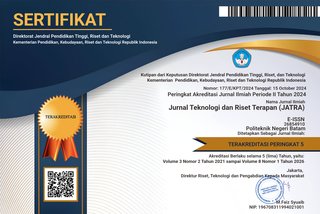Hazard Identification And Risk Assesment (HIRA) Pada Proses Riksa Uji Mesin Crimping Semi-Otomatis
DOI:
https://doi.org/10.30871/jatra.v5i1.4708Keywords:
Penilaian risiko pekerjaan, bahaya di tempat kerja, manajemen risiko, kesehatan dan keselamatan kerja, pencegahan kecelakaanAbstract
Every phase of work activities in a workplace is inevitably associated with potential hazards and risks that can lead to both workplace accidents and occupational illnesses. To mitigate these hazards effectively, the identification and assessment of risks are imperative, providing a foundation for offering constructive recommendations to the respective companies. The process of hazard identification and risk assessment adheres to the risk management stages, aligned with the AS/NZS 4360:2004 standard on Risk Management, encompassing the determination of consequences (severity) and probability levels (likelihood) to ascertain the risk levels within each work process phase. Upon establishing these risk levels, comprehensive recommendations for control programs can be devised, aimed at averting workplace accidents and occupational diseases. Data acquisition is carried out through surveys/observations involving workers and document reviews. The observations were conducted within the production area, specifically focusing on the semi-automatic crimping machine inspection process at PT. SWS in December 2022. The research findings reveal that within the crimping machine inspection process, the risk percentages are distributed as follows: 0% at the extreme risk level, 65% at the high risk level, 35% at the moderate risk level, and 0% at the low risk level. Effective control and supervision measures are essential to prevent the occurrence of workplace accidents and occupational illnesses. These measures offer significant benefits, encompassing enhanced work productivity, improved work morale, and a fortified corporate reputation. The researcher proposes a range of control measures, spanning substitution, engineering, administrative adjustments, and personal protective equipment provisioning.
Downloads
References
B. O. (Benjamin O.) Alli, Fundamental principles of occupational health and safety. International Labour Office, 2008.
Ciptadi Tatag Tur Raharja, Deri Teguh Santoso, Rizal Hanifi, and Nanang Burhan, "Analisis Kinerja Mesin Crimping Dengan Metode Overall Equipment Effectiveness di CV. ABC," TRAKSI: Majalah Ilmiah Teknik Mesin, vol. 21, no. 2, pp. 195"“217, 2021.
L. M. Kurniawidjaja, Teori dan aplikasi kesehatan kerja. Universitas Indonesia Publishing, 2012.
BSN, "Standar Nasional Indonesia Sistem manajemen keselamatan dan kesehatan kerja (SMK3)-Persyaratan dan pedoman penggunaan Occupational health and safety management systems-Requirements with guidance for use," 2018.
Standards Australia and Standards New Zealand, Risk Management Guidelines Companion to as/nzs 4360:2004. Standards Australia International Ltd., 2004.
Annisa Fyona, Miduk Parulian Nababan, Budi Baharudin, and Rahman Hakim, "Analisis Proses Penentuan Kelayakan dan Pengamanan Penggunaan Overhead Crane Menggunakan Metode Pemeriksaan dan Pengujian Teknis K3," Jurnal Teknologi dan Riset Terapan, vol. 4, no. 1, pp. 21"“30, 2021.
"Peraturan Menteri Ketenagakerjaan Keselamatan dan Kesehatan Kerja Lingkungan Kerja No.5 Tahun 2018," 2018.
Wibowo, Ervian Ade, and Asep Erik Nugraha. "Analisis Potensi Bahaya Keselamatan dan Kesehatan Kerja Menggunakan Metode HIRA Di PT. Victorindo Kimiatama." Jurnal Serambi Engineering 8, no. 2, 2023.
Simanjuntak, L.A. and Sutarwati, S., "Analisis Penerapan Manajemen Bahaya Hewan Liar Dalam Menunjang Keselamatan Penerbangan Dengan Metode Hazard Identification and Risk Assessment (HIRA) Di Bandar Udara Internasional Hang Nadim Batam". Student Scientific Creativity Journal, 1(4), pp.273-282, 2023
Nursabrina, A. "Risk Management in Hazardous and Toxic Waste Management Companies using the HIRA (Hazard Identification and Risk Assessment) Method at PT. XY Batam City". International Journal of Health, Education & Social (IJHES), 4(12), pp.1-12., 2021.
Downloads
Published
How to Cite
Issue
Section
License
Copyright (c) 2023 Jurnal Teknologi dan Riset Terapan (JATRA)

This work is licensed under a Creative Commons Attribution-NonCommercial-ShareAlike 4.0 International License.




11.jpg)











